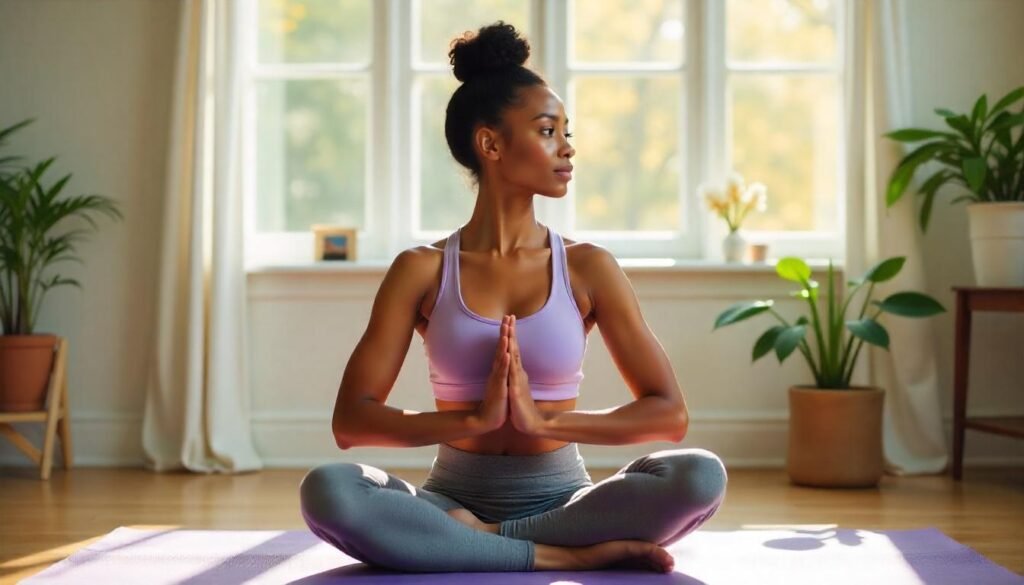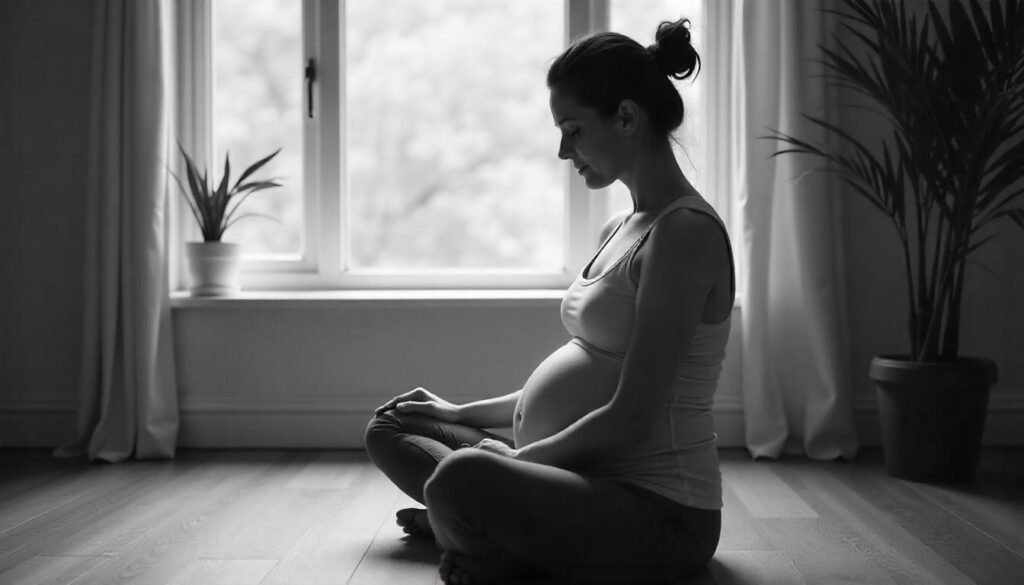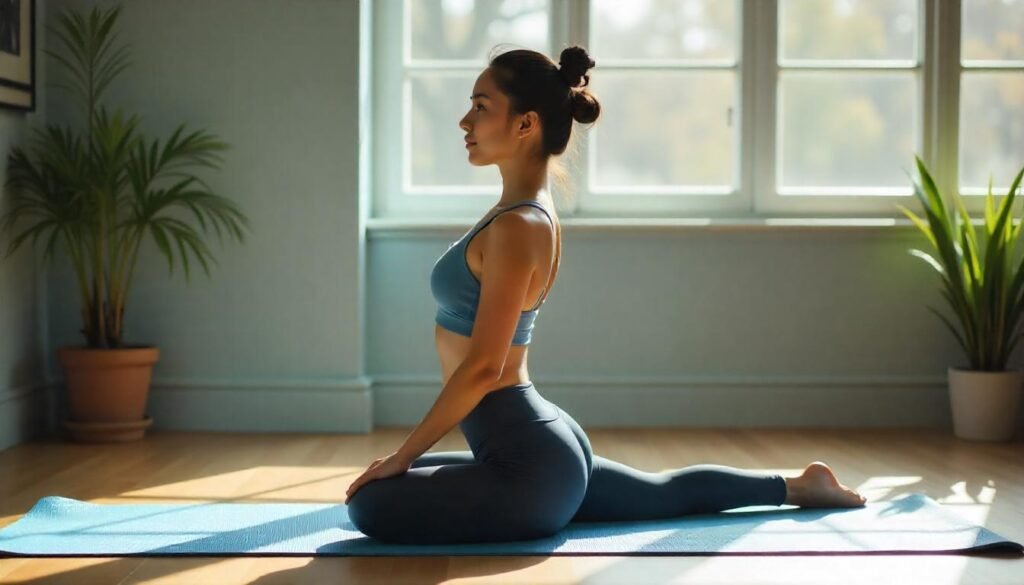Introduction to Gentle Postpartum Yoga at Home in 2025
Gentle postpartum yoga at home in 2025 is the focus of this article. The postpartum period is a time of profound transformation—a journey of healing, adjustment, and bonding with your new baby. Amidst the joy and challenges, finding a moment for self-care can feel impossible, yet it’s never been more critical. Gentle postpartum yoga offers a powerful tool for navigating this phase, providing a nurturing way to reconnect with your body, rebuild strength safely, and calm your mind. This guide provides a medically-sound, evidence-based approach to starting postnatal yoga, ensuring your return to movement is both effective and safe.
Embarking on a practice of gentle postpartum yoga poses at home is not about “bouncing back.” It’s about tuning in, listening to your body’s new needs, and fostering a foundation of strength and well-being that will support you through the demands of motherhood. For yoga for new moms, the focus is on healing from the inside out.
Table of Contents

The Science-Backed Benefits of Postnatal Yoga
The period after childbirth, often called the fourth trimester, involves significant physical and emotional changes. Research increasingly supports the use of postnatal yoga as a holistic approach to recovery.
According to a 2021 study published in Complementary Therapies in Clinical Practice, yoga can significantly reduce symptoms of postpartum depression and anxiety. Participants who engaged in a consistent yoga practice reported improved mood and a greater sense of well-being.
Key benefits include:
- Improved Core and Pelvic Floor Function: Postpartum core exercises integrated into yoga help re-engage deep abdominal muscles and the pelvic floor, which are stretched during pregnancy and delivery.
- Reduced Physical Discomfort: Gentle stretching can alleviate common postpartum aches, particularly in the back, neck, and shoulders from holding and feeding a baby. This makes postpartum yoga for back pain relief a popular choice.
- Enhanced Mental and Emotional Health: The practice’s focus on breathwork (pranayama) and mindfulness can calm the nervous system, potentially reducing the risk or severity of postpartum mood disorders. It serves as effective postnatal yoga for relaxation.
- Increased Energy Levels: While it may seem counterintuitive, gentle movement can combat fatigue by improving circulation and promoting better-quality, albeit shorter, periods of sleep.
- A Deeper Mind-Body Connection: Postpartum can leave many women feeling disconnected from their bodies. Mindful movement for postpartum bodies helps rebuild this connection with kindness and acceptance.

When Can I Start Yoga After Birth? A Guide to Safe Practice
This is one of the most critical questions, and the answer is not one-size-fits-all. The priority is always safety and allowing your body adequate time to heal.
Getting the Green Light from Your Doctor
Before starting any exercise program, including gentle postpartum yoga, you must get clearance from your healthcare provider (OB-GYN, midwife, or family doctor). This typically occurs at your postpartum check-up, usually around 6 weeks after a vaginal delivery and 8-10 weeks after a Cesarean section.
General Timelines and Considerations
- Vaginal Delivery: If you had an uncomplicated vaginal delivery, you might be cleared to begin gentle movements like walking and deep breathing exercises within a few days. You can typically begin a more structured postpartum yoga for beginners routine after your 6-week check-up.
- Cesarean Section (C-Section) Delivery: A c-section is major abdominal surgery. Your body needs more time to heal. It’s crucial to follow your doctor’s advice, which often involves waiting at least 8 weeks. Start with c-section recovery gentle yoga that avoids any direct pressure or deep stretching of the abdominal area.

Warning Signs: When to Stop and Rest
Listen to your body. Stop immediately and consult your doctor if you experience any of the following:
- Pain (sharp, sudden, or increasing)
- Increased bleeding (lochia) or a change in its color back to bright red
- Dizziness, lightheadedness, or shortness of breath
- A feeling of pressure, bulging, or heaviness in the pelvic area (could indicate prolapse)
- Doming or coning along the midline of your abdomen (a sign of unmanaged intra-abdominal pressure with diastasis recti)
7 Gentle Postpartum Yoga Poses to Try at Home
Once you have medical clearance, you can begin exploring these gentle postpartum yoga poses at home. Focus on your breath and move slowly and mindfully. A 15 minute postpartum yoga routine is a great starting point.
1. Diaphragmatic Breathing (Belly Breathing)
This is the foundation of all postpartum core exercises. It gently reawakens the deep core muscles and pelvic floor.
- How to do it: Lie on your back with your knees bent. Place one hand on your chest and the other on your belly. Inhale slowly through your nose, allowing your belly to rise as your diaphragm expands. Your chest should remain relatively still. Exhale slowly through your mouth, feeling your belly gently fall as your deep core muscles engage.
- Focus: Coordinate the breath with a gentle pelvic floor lift (like stopping the flow of urine) on the exhale.
2. Cat-Cow Pose (Marjaryasana-Bitilasana)
This pose gently mobilizes the spine and can help relieve back pain.
- How to do it: Start on your hands and knees in a tabletop position. As you inhale, drop your belly, lift your chest and tailbone, and look slightly forward (Cow Pose). As you exhale, round your spine toward the ceiling, tucking your chin and tailbone (Cat Pose).
- Focus: Keep the movements fluid and connected to your breath. Avoid pushing to your maximum range of motion.
3. Child’s Pose (Balasana)
A classic restorative pose that gently stretches the hips, thighs, and lower back while promoting relaxation.
- How to do it: From tabletop, bring your big toes to touch and widen your knees slightly. Sit your hips back toward your heels and fold forward, resting your forehead on the mat.
- Modification: If your hips are tight, place a folded blanket or bolster between your thighs and calves. This is one of the best supported yoga poses for new moms.
4. Bridge Pose (Setu Bandhasana)
This pose strengthens the glutes and hamstrings, which supports the pelvis and lower back, without straining the abdomen.
- How to do it: Lie on your back with your knees bent and feet flat on the floor, hip-width apart. As you exhale, press through your feet to lift your hips off the floor. Keep your thighs parallel.
- Focus: Engage your glutes to lift, not your lower back. Avoid lifting too high. This is a safe yoga after childbirth at home staple.
5. Legs-Up-the-Wall Pose (Viparita Karani)
An incredibly restorative pose that can help reduce swelling in the legs and feet and calm the nervous system.
- How to do it: Sit sideways next to a wall. Swing your legs up the wall as you lie back. Your sitting bones should be as close to the wall as is comfortable.
- Focus: Close your eyes and focus on your diaphragmatic breathing. Stay for 5-10 minutes.
6. Supported Fish Pose (Matsyasana)
This pose gently opens the chest and shoulders, counteracting the rounding posture common from feeding and carrying a baby.
- How to do it: Place a rolled-up blanket or yoga bolster lengthwise along your spine. Lie back over it so it supports you from your lower back to your head. Let your arms rest out to the sides.
- Focus: This is a key pose in any healing yoga flow after birth.

7. Corpse Pose (Savasana)
Do not skip this pose. It is essential for integration and relaxation.
- How to do it: Lie flat on your back, letting your feet fall open naturally. Rest your arms by your sides, palms facing up. Close your eyes.
- Focus: Simply rest. Allow your body to feel heavy and supported by the floor. This is a core component of postnatal yoga for relaxation.
Targeting Common Postpartum Concerns with Yoga
Yoga for Diastasis Recti: Healing the Core
Diastasis recti is the separation of the rectus abdominis muscles. Aggressive ab work like crunches can make it worse. The key is to rebuild the deep core (transverse abdominis).
- What to do: Focus on diaphragmatic breathing and gentle core engagements. Poses like Cat-Cow and gentle pelvic tilts are beneficial.
- What to avoid: Avoid planks, crunches, and any movement that causes your belly to “cone” or bulge. A consultation with a pelvic floor physical therapist is highly recommended for a personalized diastasis recti yoga fix at home.
Pelvic Floor Strengthening Yoga Postpartum
Your pelvic floor has been through a lot. Pelvic floor yoga involves both strengthening (Kegels) and, just as importantly, learning to relax these muscles.
- How to do it: Integrate gentle pelvic floor lifts (Kegels) with your exhale during poses like Bridge Pose and diaphragmatic breathing. Poses like Child’s Pose and Happy Baby help release tension.

Conclusion: Your Body, Your Journey
Your postpartum recovery is a unique and personal journey. Incorporating gentle postpartum yoga into your routine can be a beautiful act of self-care, helping you heal physically and emotionally. Remember to always move with intention, honor your body’s limits, and celebrate the incredible work it has done. The goal is not perfection, but connection.
Crucially, always speak with your healthcare provider or a qualified pelvic floor physical therapist before beginning any new exercise regimen, including postnatal yoga, to ensure it is safe and appropriate for your individual recovery needs.
Frequently Asked Questions (FAQs)
1. How often should I do postpartum yoga? When you are first starting, aim for short sessions of 10-15 minutes, 3-4 times a week. Listen to your body—some days you may have more energy than others. Consistency is more important than intensity or duration.
2. Can yoga help with postpartum anxiety? Yes, it can be a very effective tool. Research, including studies from institutions like the National Institutes of Health (NIH), suggests that the combination of physical movement, controlled breathing, and mindfulness in postpartum yoga for anxiety can help regulate the nervous system and reduce feelings of stress and overwhelm.
3. What yoga poses should I avoid after a c-section? After a c-section, and once cleared for exercise, you should avoid any poses that put direct pressure on your scar or involve deep abdominal twisting or stretching for several months. Avoid deep forward folds, strong backbends, and traditional core work like Plank or Boat Pose until your incision and underlying tissues are fully healed and you have rebuilt foundational core strength.
4. Is it okay to do yoga if I have diastasis recti? Yes, but it must be modified. A proper yoga for diastasis recti routine avoids any movement that increases intra-abdominal pressure, like crunches or sit-ups. The focus should be on deep core breathing and strengthening the transverse abdominis. Consulting a physical therapist who specializes in postpartum recovery is the best way to get a safe and effective plan.



